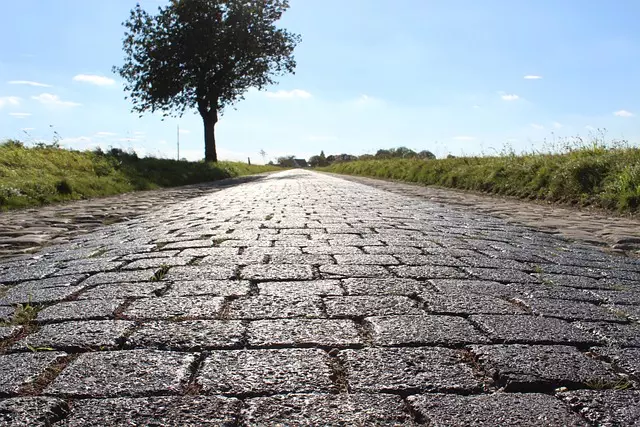Optimizing Traffic Flow with Pavement Milling and Grinding: Insights from Toledo’s Roadways
Pavement milling and grinding are essential processes for maintaining urban roadways, as demonstrat…….
All About Pavement Milling and Grinding Toledo Ohio
Pavement Milling and Grinding in Toledo, Ohio: A Comprehensive Analysis
Introduction
Pavement milling and grinding are essential processes in maintaining and upgrading road infrastructure. In Toledo, Ohio, these operations play a pivotal role in ensuring the safety and efficiency of its transportation network. This article delves into the intricacies of pavement milling and grinding in Toledo, Ohio, exploring its significance, technological advancements, economic impact, and future prospects. Readers will gain a comprehensive understanding of how this process contributes to the city’s infrastructure and the broader landscape of road maintenance and urban development.
Understanding Pavement Milling and Grinding in Toledo, Ohio
Pavement milling and grinding are mechanical processes used to remove the surface course of asphalt pavements. In Toledo, these processes are integral to road reconstruction, rehabilitation, and maintenance projects. The core components include milling machines that grind away at the pavement’s top layer, and grinding equipment that smooths and levels the remaining material. This historical practice has evolved over time, with its origins in the early 20th century when the need for efficient road maintenance became evident.
The significance of pavement milling and grinding lies in its ability to extend pavement life, improve ride quality, and facilitate the repair of underlying structural issues. It is a sustainable practice that recycles materials from the existing pavement, reducing the need for virgin asphalt and minimizing environmental impact.
Global Impact and Trends
The influence of pavement milling and grinding extends beyond Toledo’s city limits, with global trends shaping its practice. The growing demand for infrastructure development and maintenance worldwide has led to advancements in this field. Regions such as North America, Europe, and Asia are adopting these techniques at varying rates, influenced by factors like available technology, budgetary constraints, and environmental regulations.
Innovations in equipment and processes have significantly improved the efficiency and quality of milling and grinding operations globally. The use of recycled materials is becoming more common, not only reducing costs but also promoting sustainability. The global market for pavement maintenance equipment is expanding, with manufacturers continuously developing new machinery that enhances performance and minimizes disruptions to traffic flow.
Economic Considerations
The economic aspects of pavement milling and grinding are multifaceted. These operations require significant investment but offer long-term cost benefits by extending the life of road infrastructure and reducing maintenance costs over time. In Toledo, the economic impact is felt not only in public sector investments but also in the private sector through job creation and the stimulation of related industries such as material supply and equipment manufacturing.
Milling and grinding are part of a cyclical economy where materials removed from the pavement are reused in new construction projects. This closed-loop system contributes to cost savings and has a positive effect on the local and national economies. The investment patterns in infrastructure development often reflect the importance of maintaining and upgrading existing road networks through such processes.
Technological Advancements
Technological advancements have transformed pavement milling and grinding operations. Modern machinery is equipped with GPS and laser guidance systems, which enhance precision and efficiency. These technologies allow for real-time adjustments and monitoring of the work being done, ensuring that the desired pavement profile is achieved.
Innovations such as electric or hybrid machines reduce emissions on job sites, addressing environmental concerns while improving operational performance. The development of advanced milling and grinding techniques has also led to better management of subgrade preparation, which is crucial for the longevity of road infrastructure.
Policy and Regulation
Policies and regulations governing pavement milling and grinding are critical in ensuring that these operations are performed safely, efficiently, and sustainably. In Toledo, as well as across the United States, regulations set forth by federal, state, and local agencies dictate the standards for road construction and maintenance. These include environmental protections, work zone safety, and material specifications.
Legislation such as the Federal Highway Administration’s (FHWA) guidelines on pavement preservation influences how milling and grinding operations are conducted. Compliance with these regulations is not only a legal requirement but also a benchmark for quality in road maintenance practices.
Challenges and Criticisms
Despite its benefits, pavement milling and grinding faces challenges and criticisms. One of the primary concerns is the impact of these operations on traffic flow and public mobility. Ensuring minimal disruption while carrying out these projects is a significant challenge for municipalities and contractors alike.
Another criticism is the potential for airborne particulate matter emissions during the milling process, which can pose health risks if not properly managed. Advances in technology and stringent environmental controls have mitigated these issues, but continued vigilance and innovation are necessary to address any remaining concerns.
Future Prospects
The future of pavement milling and grinding in Toledo and beyond is bright, with ongoing advancements in technology and a growing recognition of its importance in sustainable infrastructure management. The adoption of smart technologies, such as intelligent compaction systems and machine monitoring tools, will further enhance the efficiency and quality of these operations.
Moreover, the focus on green construction methods and the use of recycled materials is expected to increase, aligning with global environmental objectives. As urban populations grow and infrastructure demands intensify, the role of pavement milling and grinding will become even more critical in maintaining a functional and sustainable transportation network.
Conclusion
Pavement milling and grinding are essential components of road maintenance and urban infrastructure management. In Toledo, Ohio, these operations are conducted with precision and innovation, contributing to the city’s economic vitality and environmental sustainability. As technology continues to advance and global trends evolve, the practices surrounding pavement milling and grinding will undoubtedly adapt, ensuring that Toledo’s road network remains safe, efficient, and ready to meet the needs of its residents for years to come.

Pavement milling and grinding are essential processes for maintaining urban roadways, as demonstrat…….

This article delves into the intricacies of pavement removal methods, with a particular focus on pav…….

In Toledo, Ohio, pavement milling and grinding play a critical role in the maintenance and enhancem…….

The article discusses the importance of pavement milling and grinding in Toledo, Ohio, emphasizing …….

The implementation of pavement milling and grinding in Toledo, Ohio has significantly enhanced road …….